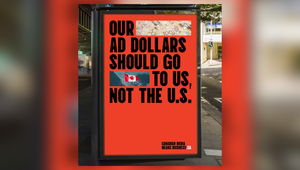
“You Can Fire Me If It Fails”: What Instacart and Angel Soft’s Super Bowl Bets Reveal About Modern Marketing Leadership

Instacart CMO Laura Jones' boss asked, ‘How do I know it’s going to work?' when she pitched making the brand's debut Super Bowl spot.
“And I said, ‘You can fire me if it doesn’t’,” Laura told the audience at a panel on the LBB Beach during Cannes Lions.
It was a sentiment echoed by Angel Soft’s brand director, Desiree DeRose, who also took a professional gamble to bring her brand’s first Big Game spot to life this year.
“I remember saying, if we do this and it doesn’t work, that’s on me,” said Desiree. “But I knew that if we didn’t do it, we’d miss an opportunity to show up in culture.”
Both leaders now find themselves shortlisted at Cannes Lions for those very campaigns. On a panel joined by Diageo global director, beer, liqueur and vodka, Gráinne Wafer and moderated by LBB AUNZ managing editor Brittney Rigby, the marketers discussed how big creative bets and strong internal alignment are necessary to thrive in today’s volatile, high-stakes environment.
High Risk, High Reward Still Matters
Both Instacart (a US and Canadian delivery platform) and toilet paper brand Angel Soft's Super Bowl plays were more than just media buys -- they were career-defining bets. Laura’s campaign brought together a surreal cast of grocery aisle mascots, delivering a nostalgic punch that drove a 72% increase in new-to-site visitors and a 14% sales lift in for the ‘We’re Here’ Big Game spot. But the goal wasn’t just performance, said Laura – it was about brand transformation.
“We wanted to show up in a way that redefined what people think Instacart is,” she said. “It wasn’t just about a media buy – it was a chance to tell a much bigger brand story.”
Desiree similarly flipped category conventions on their head with an unusual call-to-action in Angel Soft's debut Super Sunday spot, ‘The Big Game Potty-tunity’ by urging viewers: “Don’t watch the ad – go to the bathroom instead.”
“We wanted to be part of the moment, but also say something unexpected,” she said. “So we flipped the script – and told people not to watch the ad. That ad broke through in a category that doesn’t usually get to play in culture.”
Every Impression Performs
Both marketers made it clear that brand and performance are no longer separate tracks. “Every dollar must perform,” said Laura. “And every impression builds your brand – whether you like it or not.”
This thinking has shifted how Instacart approaches media.
“We’re investing at the top of the funnel -- in things like the Olympics and the Super Bowl -- but we’re rigorous about tying those to clear outcomes,” she explained. “There’s no such thing as brand work that’s just about awareness anymore.”
Desiree added, “Even in a functional category, like toilet paper, everything has to pay rent back to the brand. That might mean driving business results, but it also means staying top of mind emotionally.”
Both brands are rethinking their media mix in 2025.
“We’re leaning into full-funnel video and cultural content partnerships,” said Laura. “And pulling back on anything that doesn’t connect with out audiences meaningfully or scale effectively.”
Creative Courage Requires Organisational Support
Laura’s “fire me” moment might sound dramatic, but it was grounded in trust, and proof.
“You have to trust the process,” she said. “But you also need to make the business case. We were very about the ROI potential, and we brought the whole company along.”
Desiree agreed: “Bravery in marketing isn’t solo – you need the support of your legal team, your comms team, your leadership. If you can explain the ‘why’, they’ll often back you.”
The conversation highlighted how CMOs must not only have bold ideas but also navigate the internal politics and operational reality to make them happen.
“We knew this was a moment for us to act like a challenger brand,” said Desiree. “And thankfully, the organisation was willing to take that leap with us.”
The Long View Still Counts
Gráinne -- whose portfolio includes Guinness, Smirnoff, and Baileys -- reminded the audience that long-term brand building remains the north star, particularly against the pressure of having to perform in the short term.
“We pay people to bring us great ideas,” she said. “So when the spark appears, we have to fund it, even if it wasn’t in the original plan.”
She emphasised the importance of creating room for agility without abandoning strategic consistency.
“Some of our best work has come when we’ve been able to move quickly, but always within a broader, long-term framework,” said Gráinne.
That means resisting the temptation to chase short-term trends at the expense of brand equity.
“As CMOs, it’s our responsibility to hold the long views,” she said. “We need to invest in ideas that build over time – rooted in curiosity, culture and consistency.”
And even as budgets tighten, that lens hasn’t changed.
“We still have to spend every penny wisely,” said Gráinne. “But that doesn’t mean being safe. It means being smart, and staying bold.”
As the panel wrapped, she brought the conversation full circle, underscoring a CMO’s ultimate responsibility, long-term growth.
“We have to think in years, not just quarters,” she said. “That’s our job. If we’re not championing long-term thinking, who is?”















